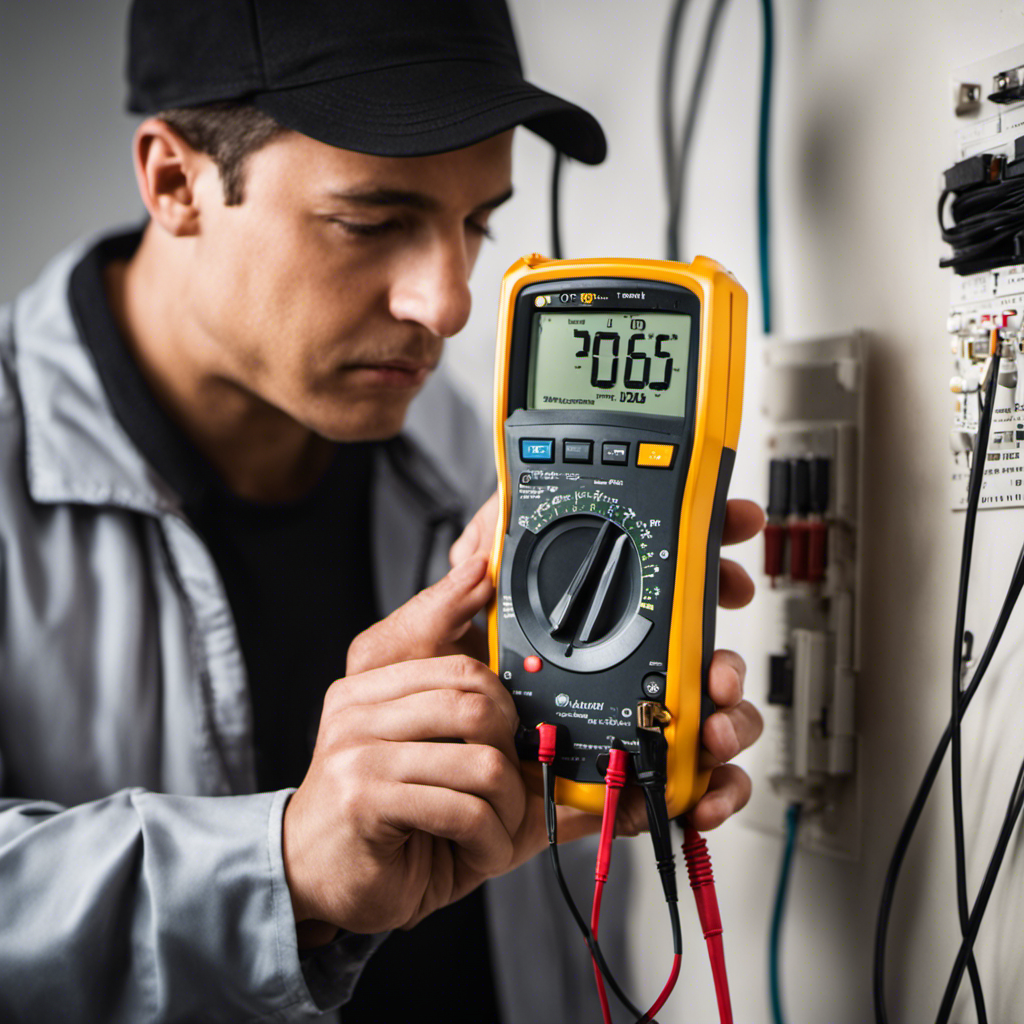In this article, we will explore the question of whether a thermostat can be tested.
As a crucial component of any heating and cooling system, it is essential to ensure that a thermostat is functioning accurately and efficiently.
By examining temperature accuracy, functionality, heat/cool cycling, sensor calibration, energy usage, and troubleshooting common issues, we will provide valuable insights and guidance for those seeking to serve others by maintaining optimal indoor comfort and energy efficiency.
Key Takeaways
- Temperature accuracy and calibration can be tested by comparing readings with a secondary thermometer and observing fluctuations, checking the thermostat’s calibration, and consulting a professional technician if recalibration or replacement is needed.
- The functionality of thermostat settings can be tested by setting different temperature settings, observing the system’s response, testing for programming accuracy, and checking for manual override capabilities to ensure reliable operation.
- Proper heat/cool cycling can be tested by setting the thermostat to the desired temperature, monitoring heat distribution and temperature fluctuations, and checking if the system responds effectively to temperature changes for efficient heating and cooling regulation.
- Sensor calibration can be assessed by comparing the thermostat’s temperature readings with a reliable thermometer, checking sensor alignment, and consulting a professional technician if recalibration or replacement is necessary to ensure the proper functioning of the thermostat’s temperature sensor.
Checking Temperature Accuracy
To ensure accurate temperature readings, it is important to test the thermostat using various methods.
One way to do this is by comparing temperature readings with a secondary thermometer. Place the secondary thermometer close to the thermostat and record the temperature displayed on both devices. If there is a significant difference, it may indicate that the thermostat is not functioning properly.
Another method is to explore temperature fluctuations. Set the thermostat to a specific temperature and observe if it maintains a consistent temperature or if it fluctuates. Fluctuations could be a sign of a faulty thermostat.
Additionally, checking the thermostat’s calibration can also help verify its accuracy.
Verifying Functionality of Settings
By checking the responsiveness of the thermostat’s settings, one can verify its functionality and ensure that it operates as intended. To verify the programming accuracy, it is crucial to set the thermostat to different temperature settings and observe if the system responds accordingly.
For instance, if the thermostat is programmed to maintain a certain temperature during specific times of the day, it should adjust the heating or cooling system accordingly. Additionally, testing for manual override capabilities is essential to ensure that users can manually adjust the temperature when needed, regardless of the programmed settings.
This can be done by attempting to override the programmed settings and observing if the thermostat responds accordingly. Verifying the functionality of the settings is crucial to guarantee that the thermostat operates reliably and provides the desired comfort for users.
Testing for Proper Heat/Cool Cycling
Ensuring proper heat/cool cycling can be achieved by monitoring the thermostat’s ability to accurately maintain the desired temperature range. To test for proper heat/cool cycling, it is important to check the heat distribution throughout the space and analyze temperature fluctuations.
Start by setting the thermostat to the desired temperature and observe how the system responds. The heat or cool cycle should kick in when the temperature goes below or above the set range, respectively. Monitor the temperature closely to see if it stays within the desired range or if there are significant fluctuations. If the temperature fluctuates too much, it may indicate a problem with the thermostat’s ability to regulate the heating and cooling system effectively.
Additionally, check the heat distribution in different areas of the space to ensure that the thermostat is evenly distributing the heat or cool air. By conducting these tests, you can ensure that the thermostat is functioning properly and maintaining a comfortable temperature for the users.
Assessing Sensor Calibration
For accurate assessment of sensor calibration, it is crucial to compare the thermostat’s temperature readings with a reliable and precise thermometer. This allows you to determine the level of accuracy and reliability of the thermostat’s temperature sensor.
To begin, ensure that the sensor alignment is correct, as any misalignment can lead to temperature deviations. Place the thermometer near the thermostat and observe the temperature readings displayed by both devices.
If there is a significant temperature deviation, it may indicate that the thermostat’s sensor calibration is off. In such cases, it is recommended to consult a professional technician who can properly recalibrate the thermostat’s sensor or replace it if necessary.
Evaluating Energy Usage and Efficiency
To accurately evaluate energy usage and efficiency, it is important to analyze the patterns and trends of energy consumption over a specific period of time. By doing so, one can identify areas where energy-saving techniques can be implemented and make informed decisions when comparing different thermostat models.
Evaluating energy usage involves monitoring the amount of energy consumed by the thermostat and analyzing the data to identify any inefficiencies or excessive energy use. This can be done by tracking energy consumption on a daily, weekly, or monthly basis.
Comparing different thermostat models can also help in assessing their energy-saving capabilities and efficiency ratings. By considering factors such as programmable settings, energy-saving features, and user-friendly interfaces, individuals can select a thermostat that best suits their needs while maximizing energy efficiency.
Troubleshooting Common Thermostat Issues
The malfunctioning thermostat can cause various issues in the heating and cooling system. When troubleshooting common thermostat issues, it is important to start by checking for wiring problems. Faulty or loose wiring connections can disrupt the communication between the thermostat and the HVAC system, leading to erratic temperature control or a complete system failure.
Inspecting the wiring for any signs of damage or loose connections and ensuring proper insulation can help resolve these issues.
Additionally, it is recommended to check for firmware updates for the thermostat. Manufacturers often release firmware updates to address bugs or enhance the functionality of the thermostat. Updating the firmware can potentially resolve performance issues and improve the overall operation of the thermostat.
Frequently Asked Questions
How Often Should a Thermostat Be Replaced?
A thermostat’s lifespan can vary, but it is generally recommended to replace it every 10-15 years. Signs of thermostat failure include inconsistent temperature, unresponsive controls, and frequent system cycling. Regular maintenance and testing can help identify any issues.
Can a Thermostat Be Repaired if It Is Not Functioning Properly?
Yes, a thermostat can be tested to diagnose and resolve common issues. Testing methods include checking for power supply, calibrating temperature readings, and verifying proper functioning of the control system.
Are There Any Safety Precautions to Consider When Testing a Thermostat?
Safety measures and best practices should always be followed when testing a thermostat. It is important to ensure that the power is disconnected, equipment is handled with care, and all necessary precautions are taken to prevent any accidents or damages.
What Are Some Signs That Indicate a Thermostat May Need to Be Replaced?
Some signs that indicate a thermostat may need to be replaced include inconsistent temperature, unresponsive controls, and frequent cycling. To troubleshoot thermostat issues, ensure proper power supply, check for loose connections, and consult a professional if necessary.
Can a Thermostat Be Tested Without Professional Assistance?
DIY thermostat troubleshooting can help identify common thermostat problems without professional assistance. By following step-by-step guides and utilizing online resources, individuals can perform basic tests to determine if a thermostat is functioning properly.


